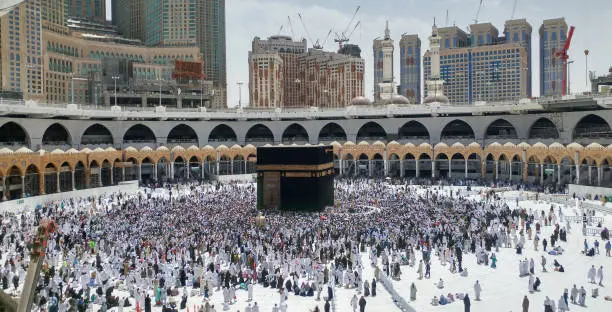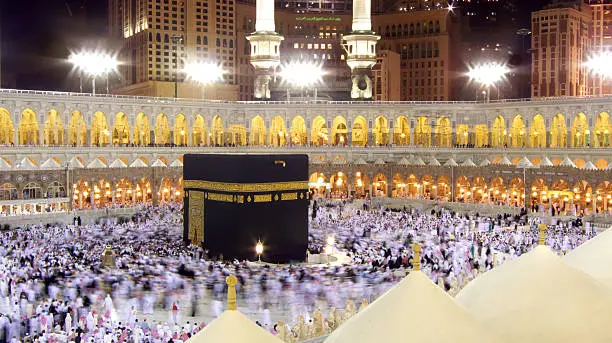Exploring Tawaf Al-Ifadah: The Essential Rite of Hajj ,We receive many questions about Tawaf Al-Ifadah, including: What is the Ifadah Tawaf and why was it given this name? Therefore, we will explain the meaning of the Tawaf Al Ifadah and the Ifadah Tawaf after decommissioning. We also explain through the article the time of the Tawaf Al Ifadah during Umrah and the time during which the Tawaf is permissible, in addition to clarifying the ruling in the case of The muhrim does not perform the Tawaf Al Ifadah, and does it replace the Farewell Tawaf or not?
What is Tawaf Al-Ifadah?
Many individuals did not understand the correct concept of Tawaf Al Ifadah, and therefore we will explain the following:
- It is a type of Tawaf Al Ifadah performed by the pilgrim in Mecca, which is performed on the first day of Eid.
- It is also one of the pillars that a person performs when performing the Hajj obligation, and on which the pilgrim’s ihram depends.
- The pilgrim performs tawaf after spending the night in Muzdalifah, and performs the stoning, as well as slaughtering and shaving.
- This type of tawaf is called the Tawaf Al Ifadah, Fard, Sadr, Ziyarah, or Rukn.

Read also: 10 Essential Sunnah Practices Every Hajj Pilgrim Should Know.
Ruling on Tawaf Al Ifadah
We receive many questions, including what is Tawaf Al Ifadah and what is the ruling on this Tawaf Al Ifadah, and therefore we will explain it as follows:
- Tawaf Al Ifadah is one of the pillars that a Muslim must perform in order to complete the Hajj properly.
- It is considered one of the pillars of Hajj that may not be performed by another person on behalf of the person in ihram
- It is also one of the matters on which the ihram depends, so whoever abandons it must return to Mecca to perform Tawaf.
- Since without Tawaf Al Ifadah, the person remains in ihram and is not permitted to have intercourse, whether a man or a woman.
- Therefore, in the event of intercourse, the ihram must perform the slaughter inside Mecca and feed the poor.
- This Tawaf Al Ifadah is like the largest Tawaf, which is performed after Duha on the first day of Eid.
Tawaf Al-Ifadah and Farewell
Some people wonder what is the Tawaf Al Ifadah and does this Tawaf replace the Farewell Tawaf? This is what we answer in the following:
- In fact, the Farewell Tawaf is the last circumambulation that the pilgrim performs in the Sacred House.
- Tawaf Al Ifadah is also performed by the pilgrim in the Sacred House and thus serves the same purpose as the Farewell Tawaf.
- Therefore, it is permissible to combine them at the same time and do sa’y after that.
- Where the Malikis worked to ease the burden on menstruating women when circumambulating.

Read also: how hajj is performed step by step? | Top Quran Classes.
Why was Tawaf Al-Ifadah given this name?
What is the Tawaf Al Ifadah and what is the reason behind calling it Tawaf Al Ifadah? These questions come to us about the Tawaf Al Ifadah, and here is the reason for calling it this name:
- The term Al-Ifadah refers to the way in which the pilgrim walks from Mina to Mecca.
- The pilgrim walks in a crawling manner when he walks very quickly after throwing stones at Aqaba.
- Therefore, it will be after completing or breaking the fast from Mina.
Time for Tawaf Al-Ifadah
The preferable time or the recommended time for performing Tawaf Al Ifadah is the first day of the day on the Day of Sacrifice, after the pilgrim stones the Jamarat, sacrifices the sacrificial animal, and shaves his head. This is the preferred time. As for the legitimate time for performing Tawaf Al Ifadah; The following is an explanation of it and a statement of what scholars say regarding its definition:The beginning time for the Tawaf Al Ifadah: The scholars agreed that the Ifadah Tawaf takes place after the pilgrim stops at Arafat, but they differed in determining the beginning time for the Tawaf Al Ifadah, based on two opinions:
- The time for Tawaf Al Ifadah begins after midnight for those who have previously stopped at Arafat, and the Shafi’is and Hanbalis adhere to this opinion.
- The time for Tawaf Al Ifadah begins from the rising of the second dawn on the Day of Sacrifice.
The last time for the Tawaf Al Ifadah: The pilgrim may delay the Ifadah Tawaf until the Day of Sacrifice, and perform it on the days of Tashreeq. As for the last time for performing the Tawaf Al Ifadah; There is no limit to the end of its obligatory performance according to the agreement of the jurists, except that they differed regarding the consequences of the one who delays it according to the sayings, which are:
- The obligation of blood; That is, slaughtering a sacrificial animal if the pilgrim delays Tawaf Al Ifadah beyond the days of sacrifice, but if he performs it on the days of sacrifice, then there is nothing wrong with him, and this is the Hanafi doctrine.
- It is obligatory to pay a blood donation if the pilgrim delays performing Tawaf al-Ifadah beyond the month of Dhul-Hijjah, but if he performs it in the month of Dhul-Hijjah, then there is nothing on him, and this is what is well-known among the Malikis.
- There is absolutely nothing imposed on the pilgrim if he delays the Ifadha Tawaf, according to the Shafi’is and Hanbalis.

Conditions for Tawaf Al-Ifadah
In general, a number of conditions are required for circumambulation of the Sacred House, such as Islam, sound mind, intention, purity from impurity, covering the private parts, purity of clothing, and the like. As for the conditions specific to Tawaf Al Ifadah, they are:
- The circumambulation must be preceded by ihram. Because any Hajj action stops while in Ihram.
- The pilgrim should stop before Tawaf Al Ifadah at Arafat; If the pilgrim performs the Tawaf Al Ifadah before stopping at Arafat, the obligation of the Tawaf Al Ifadah will not be waived from him.
- The prescribed time for the Tawaf has begun – its time has been previously stated – so if the pilgrim performs the Tawaf before its time has entered, it is not valid.
Conclusion
After the pilgrim adheres to the conditions required for Tawaf Al Ifadah; The circumambulator comes to the Kaaba and places it on his left, and begins the circumambulation from the Black Stone and ends at it, and repeats this seven times. Because the circumambulation is seven complete circuits, and the Muslim must perform it walking if he is able to walk, and the circumambulation must be inside the Sacred Mosque; If he circumambulates outside it, it is not permissible, and around the Holy Kaaba. So, if one circumambulates inside the courtyard of the Kaaba, the circumambulation is not valid.
FAQ
1. What is Tawaf al-Ifadah?
It is the essential circling of the Kaaba performed by pilgrims after leaving the state of Ihram on the 10th of Dhul-Hijjah (Eid day). It is also called Tawaf al-Ziyarah.
2. When is Tawaf al-Ifadah performed?
It is performed after sacrificing an animal (Hady) and shaving or cutting hair, from the 10th of Dhul-Hijjah until the end of the days of Tashreeq.
3. Is Tawaf al-Ifadah obligatory in Hajj?
Yes, it is one of the essential pillars (Arkan) of Hajj. Without it, the Hajj is not valid.
4. What is the difference between Tawaf al-Ifadah and Tawaf al-Wadaa?
Tawaf al-Ifadah is a pillar of Hajj, while Tawaf al-Wadaa (Farewell Tawaf) is obligatory but can be skipped by menstruating women or residents of Makkah.
5. Can Tawaf al-Ifadah be delayed?
Yes, it can be performed any time from the 10th to the 13th of Dhul-Hijjah, but it is highly recommended to perform it on the 10th.
Still have questions? Contact us now to answer your questions

